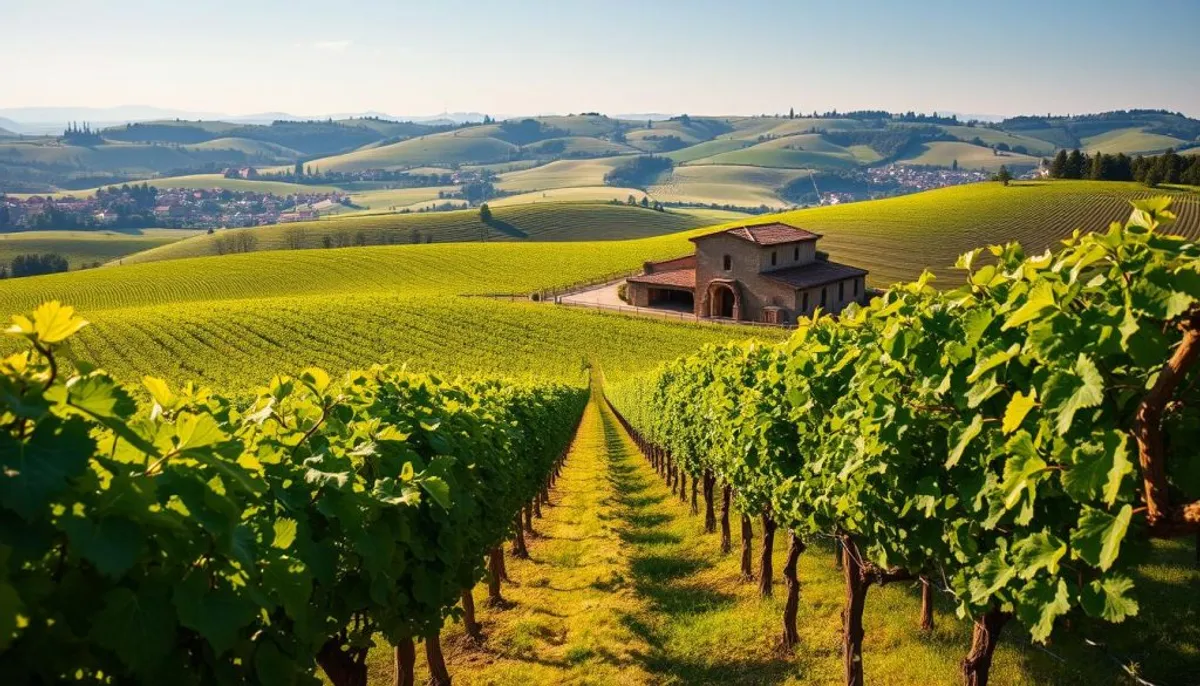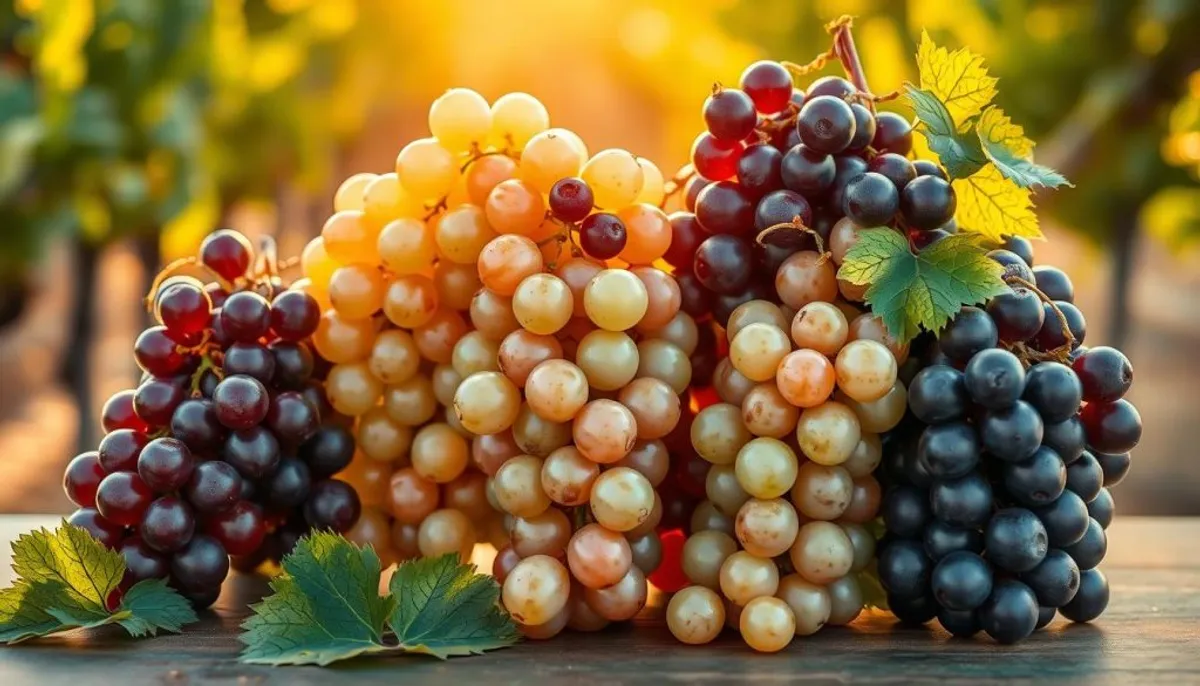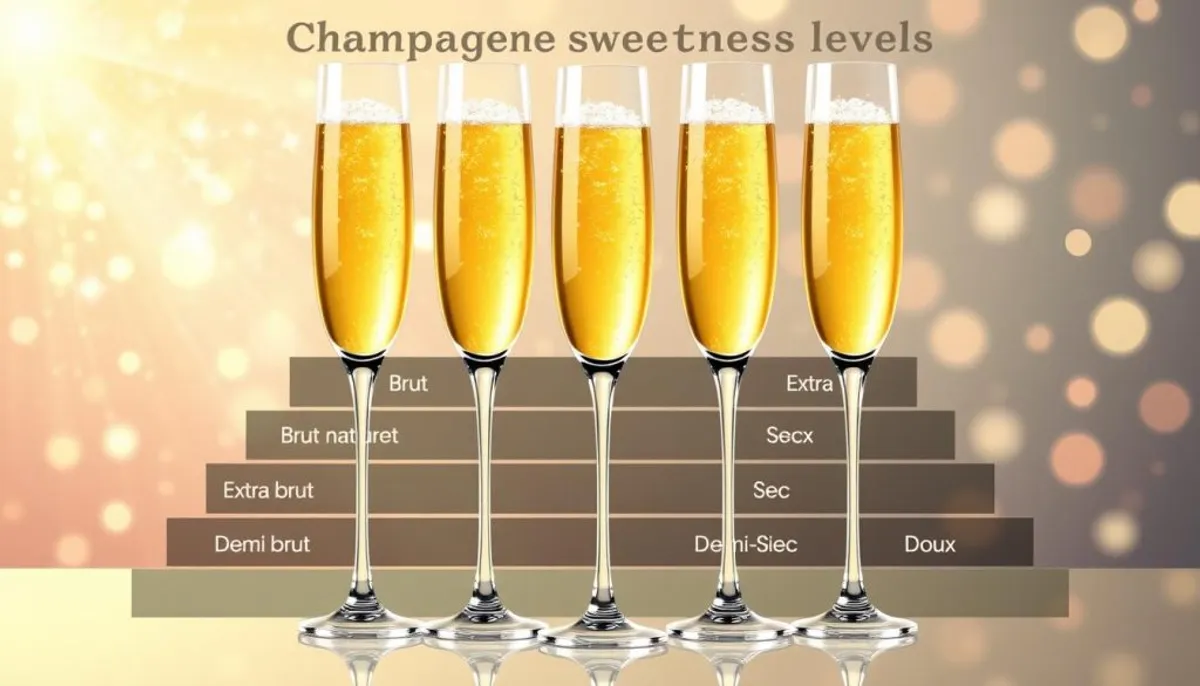Welcome to the world of Champagne LT, your premier source for exquisite sparkling wines from France’s Champagne region. Our guide takes you through the vineyards and production methods that make Champagne the king of bubbles. Whether you’re new to Champagne or a seasoned expert, we’re here to help you explore this celebrated beverage.
Champagne LT offers personalized quotes for exporting our premium selections worldwide. We ensure you can enjoy a taste of luxury no matter where you are. Our commitment to quality extends from the champagne vineyards to your doorstep.

Did you know that Champagne has outperformed traditional assets like gold and major stock indices? The Liv-Ex Champagne 50 Index shows impressive growth, sparked by outstanding vintage years. This surge in interest highlights Champagne’s value as both a luxury and an investment.
The méthode champenoise, Champagne’s production process, is labor-intensive and ensures high-quality standards. This careful crafting, combined with the rarity of vintage bottles, contributes to Champagne’s value appreciation over time.
Key Takeaways
- Champagne LT offers worldwide shipping with personalized quotes
- Champagne has outperformed traditional investment assets
- The 2008 vintage sparked increased interest in Champagne investment
- Méthode champenoise ensures high-quality standards
- Rarity and unique aging characteristics contribute to value appreciation
- Rosé Champagne production has grown significantly in recent years
Understanding Champagne: More Than Just Bubbles
Champagne, a sparkling wine, is celebrated for its effervescence and storied past. Its unique terroir, a blend of soil, climate, and geography, imbues it with distinctiveness. Originating from a specific region in France, it distinguishes itself from other sparkling wines. The champagne lady embodies the elegance and sophistication associated with this luxurious drink.
What Makes Champagne Different from Other Sparkling Wines
Champagne production adheres to strict protocols. The traditional method, or méthode champenoise, involves a secondary fermentation within the bottle. This process is responsible for champagne’s fine bubbles and intricate flavors.
The Protected Designation of Origin
Sparkling wines from France’s Champagne region alone can be labeled as Champagne. This designation guarantees authenticity and quality. The average cost of a premium champagne bottle is approximately €35, reflecting its exclusive status.
Key Production Methods and Standards
Producers of champagne must adhere to stringent standards. These include specific grape varieties, harvesting techniques, and aging requirements. The terroir of champagne is pivotal in shaping its final form. Interestingly, 70% of our taste perception is derived from aroma, underscoring the significance of proper glassware in champagne enjoyment.
| Aspect | Requirement |
|---|---|
| Grape Varieties | Chardonnay, Pinot Noir, Pinot Meunier |
| Fermentation | Secondary fermentation in bottle |
| Aging | Minimum 15 months for non-vintage, 36 months for vintage |
The Art of Champagne Production
Champagne production is a meticulous process that begins in the picturesque champagne regions. The journey starts with carefully selecting champagne grapes from chalky hillsides. These grapes – mainly Chardonnay, Pinot Noir, and Pinot Meunier – form the backbone of this prestigious sparkling wine.
The unique terroir of the Champagne area imparts distinct flavors to the grapes, including various champagne varietals. After harvesting, the grapes undergo pressing and initial fermentation. The resulting base wine is then blended, a crucial step where winemakers showcase their artistry.
What sets Champagne apart is the second fermentation. This process occurs in the bottle, creating those signature bubbles. The wine ages on its lees for at least 15 months for non-vintage Champagne and 36 months for vintage varieties, highlighting the vintage champagne significance in the overall quality and character of the final product.
Riddling is another fascinating step. Bottles are gradually tilted and rotated to collect yeast sediment in the neck. Historically, skilled rémueurs turned thousands of bottles daily. Today, machines often perform this task.
The final touch involves removing the yeast sediment through disgorgement and adding the dosage – a mixture of wine and sugar that determines the Champagne’s sweetness level. This labor-intensive process contributes to Champagne’s premium status and price point.
| Grape Variety | Characteristics | Typical Usage |
|---|---|---|
| Chardonnay | Adds finesse and elegance | 15-40% of blend |
| Pinot Noir | Provides body and structure | 30-50% of blend |
| Pinot Meunier | Contributes fruitiness and roundness | 20-40% of blend |
Essential Champagne Grape Varieties
Champagne’s distinctiveness is rooted in three primary grape varieties. Each variety brings its own set of qualities to the blend, playing a pivotal role in both blending and maturation processes.
Chardonnay: The White Grape Elegance
Chardonnay, predominantly cultivated in the Côte des Blancs, imbues champagne with elegance. Its high acidity contributes to the wine’s complexity and freshness, introducing floral and citrus nuances. This grape excels in Blanc de Blancs champagnes, complementing seafood exceptionally well.
Pinot Noir: The Red Grape Backbone
Pinot Noir, prevalent in Montagne de Reims and Aube, fortifies champagne with body and structure. It infuses the wine with cherry and raspberry flavors, enriching its complexity. Pinot Noir’s adaptability is crucial, making it indispensable in blends and Blanc de Noirs champagnes.
Pinot Meunier: The Supporting Player
In the cooler Vallée de la Marne, Pinot Meunier maintains acidity and freshness in blends. It contributes vibrancy and approachability, making champagnes suitable for early consumption while still retaining aging potential. Understanding the vintage champagne significance can enhance the appreciation of these unique blends.
| Grape Variety | Primary Region | Key Characteristics |
|---|---|---|
| Chardonnay | Côte des Blancs | Elegance, high acidity, floral notes |
| Pinot Noir | Montagne de Reims, Aube | Body, structure, cherry flavors |
| Pinot Meunier | Vallée de la Marne | Vibrancy, softness, fruitiness |
The art of champagne blending requires meticulous selection and combination of these grapes. During the maturation phase, which spans at least 15 months but often reaches three years, the unique traits of each variety evolve. This evolution, along with various serving techniques, contributes to the intricate flavors that champagne is renowned for.

Exploring Champagne Styles and Classifications
Champagne presents a vast array of styles and classifications. From the non-vintage blends to the esteemed grand crus, each category exhibits distinct traits. Let’s explore the sparkling spectrum of Champagne varieties.
Non-Vintage vs. Vintage Champagne
Non-vintage Champagnes are crafted from grapes harvested over several years, ensuring a consistent taste. In contrast, vintage Champagnes are produced from grapes of a single harvest year, capturing the essence of an exceptional vintage. While non-vintage Champagnes are more prevalent, vintage selections provide a glimpse into Champagne’s historical past.
Blanc de Blancs and Blanc de Noirs
Blanc de Blancs, exclusively made from Chardonnay grapes, presents crisp, elegant flavors. Blanc de Noirs, on the other hand, is crafted from Pinot Noir or Pinot Meunier, offering a richer, fuller-bodied experience. These styles underscore the versatility of Champagne production.
Rosé Champagne Varieties
Rosé Champagne is distinguished by its pink color and fruity notes. It can be produced by blending red and white wines or through brief skin contact. The range of rosé varieties spans from delicate to bold, making them ideal for those seeking a romantic touch in their glass. For a truly memorable experience, consider the charm of a champagne lady, who adds a touch of elegance to any celebration.
Champagne prestige cuvées represent the zenith of sparkling wine craftsmanship. These luxury offerings, often sourced from the finest grand crus vineyards, showcase the finest grapes and meticulous production methods. With their complex flavors and aging potential, prestige cuvées epitomize the artistry of Champagne.
| Champagne Style | Key Characteristics | Ideal Serving Temperature |
|---|---|---|
| Non-Vintage | Consistent flavor, blend of multiple years | 8-10°C |
| Vintage | Single year harvest, unique character | 9-12°C |
| Blanc de Blancs | 100% Chardonnay, crisp and elegant | 8-10°C |
| Blanc de Noirs | Red grapes only, fuller-bodied | 9-11°C |
| Rosé | Pink hue, fruity notes | 8-10°C |
The Prestigious Champagne LT Selection
Champagne LT presents a meticulously curated assortment of sparkling wines from the most esteemed champagne vineyards. Our collaborations with distinguished producers guarantee each bottle’s adherence to the pinnacle of quality and flavor. Our range spans from the refreshing Blanc de Blancs to the opulent Vintage Champagnes, catering to diverse tastes.
Our dedication to excellence transcends mere taste. We provide a variety of bottle sizes, accommodating any high-end events. The standard 75cl bottle, ideal for intimate settings, yields approximately 6 to 7 glasses. For more elaborate celebrations, our larger formats are available:
- Magnum (150cl): Equivalent to 2 standard bottles
- Jeroboam (300cl): Ideal for parties, equals 4 standard bottles
- Methuselah (600cl): A showstopper, serving up to 48 glasses
For those in pursuit of extraordinary experiences, Champagne LT can procure rare sizes like the Melchisedech. This colossal vessel, holding 3000cl, stands 4ft tall and weighs an astonishing 100 pounds.
Regardless of your location, our export services guarantee these exquisite champagnes arrive at your doorstep. Embark on the journey of Champagne LT and enhance your sparkling wine experience today.
Understanding Champagne Sweetness Levels
Champagne sweetness is a pivotal element in its production. The dosage, added during the final stages, determines the sweetness level. This critical step in champagne blending significantly influences the wine’s taste profile.
From Brut Nature to Doux
Champagne sweetness spans from bone-dry to indulgently sweet. Brut Nature contains no added sugar, while Doux offers the sweetest experience. EU regulations permit dry wines to have up to 9 grams per liter of residual sugar.
| Sweetness Level | Sugar Content (g/L) | Taste Profile |
|---|---|---|
| Brut Nature | 0-3 | Bone-dry |
| Extra Brut | 0-6 | Very dry |
| Brut | 0-12 | Dry |
| Extra Dry | 12-17 | Off-dry |
| Sec | 17-32 | Slightly sweet |
| Demi-Sec | 32-50 | Sweet |
| Doux | 50+ | Very sweet |
Finding Your Perfect Sweetness
Brut champagnes dominate the market, accounting for nearly 90% of production. The typical dosage for modern brut champagne is 10-12 g/L. Zero dosage champagnes, with no added sugar, are gaining popularity among smaller houses.

Pairing Suggestions Based on Sweetness
Dry champagnes pair well with savory dishes, while sweeter styles complement desserts. Brut Nature works with oysters, Extra Brut with sushi, and Doux with fruit tarts. The acidity in champagne balances its sweetness, making it versatile for food pairings.
Champagne Terroir and Growing Regions
The champagne terroir is pivotal in defining the distinctive flavors of this renowned sparkling wine. With a winemaking tradition tracing back to the 5th century, the Champagne region showcases a variety of terroirs. Each contributes its own unique characteristics to the final product.
The Champagne area spans approximately 320 villages across five primary growing regions. These regions are predominantly composed of limestone and chalky soils. Such soils are ideal for cultivating the primary grape varieties used in Champagne production.
| Region | Primary Grape | Soil Type | Characteristic |
|---|---|---|---|
| Montagne de Reims | Pinot Noir | Chalk and limestone | Body and depth |
| Côte des Blancs | Chardonnay | Pure chalk | High acidity and minerality |
| Vallée de la Marne | Pinot Meunier | Clay and limestone | Fruitiness and roundness |
| Côte des Bar | Pinot Noir | Kimmeridgian limestone | Fruity and robust |
| Côte de Sézanne | Chardonnay | Chalk and clay | Elegance and finesse |
Each champagne terroir brings its own distinct qualities to the grapes. This results in the complex and balanced flavors found in premium Champagnes. The interplay of soil composition, microclimate, and grape varieties weaves a tapestry of flavors. Skilled winemakers blend these to craft exceptional sparkling wines.
Notable Champagne Houses and Their Signatures
The Champagne world is a tapestry of diverse producers, each weaving unique styles and flavors. From the historic Grande Marques to boutique producers and grower Champagnes, there’s a sparkling wine for every palate.
Historic Grande Marques
Grande Marques are the venerable houses that have shaped Champagne for centuries. These esteemed producers often create champagne grand crus, sourcing grapes from the finest vineyards. Their champagne prestige cuvées represent the pinnacle of quality and craftsmanship.
Boutique Producers
Smaller, artisanal houses focus on unique approaches to Champagne production. These boutique producers often experiment with innovative techniques, resulting in distinctive and exciting wines. Many specialize in limited-production champagne prestige cuvées, offering wine enthusiasts rare and exclusive experiences.
Grower Champagnes
Grower Champagnes come from producers who grow their own grapes and make their own wine. This farm-to-bottle approach often results in terroir-driven expressions that showcase the unique characteristics of specific vineyards. Some grower Champagnes are made from champagne grand crus, highlighting the exceptional quality of these esteemed plots.
Champagne LT’s selection includes offerings from various producer types, allowing wine lovers to explore the full spectrum of Champagne styles. Whether you prefer the consistency of Grande Marques, the innovation of boutique producers, or the individuality of grower Champagnes, there’s a perfect bottle waiting for you to discover.
Proper Storage and Serving Techniques
Mastering the art of storing and serving champagne elevates your tasting experience. Proper techniques preserve the delicate flavors and effervescence that define this luxurious beverage. Let’s explore the essentials of champagne maturation and production to ensure you savor every sip.
Temperature Guidelines
The ideal serving temperature for champagne ranges from 8°C to 10°C (46°F to 50°F). Chilling a bottle in the refrigerator takes about 3-4 hours. For quicker results, use an ice bucket with equal parts ice and water, which chills the champagne in approximately 30 minutes. Additionally, understanding proper serving techniques can enhance the overall tasting experience.
Glassware Selection
Choose tulip-shaped glasses over traditional flutes. Their wider shape enhances aroma appreciation, crucial for enjoying premium champagnes like Jacques Selosse. Fill glasses no more than two-thirds full to allow the champagne to breathe and develop its bouquet.
Storage Best Practices
For optimal champagne maturation, maintain a constant storage temperature of 12°C (53.6°F) with 70% humidity. Store bottles horizontally to keep corks moist. After opening, use a champagne stopper and store upright to minimize air exposure. These practices ensure your champagne retains its quality throughout the production and storage process.
| Aspect | Recommendation |
|---|---|
| Serving Temperature | 8°C to 10°C (46°F to 50°F) |
| Chilling Time (Refrigerator) | 3-4 hours |
| Chilling Time (Ice Bucket) | 30 minutes |
| Glassware | Tulip-shaped flutes |
| Pouring Technique | 45-degree angle, gentle pour |
Conclusion
Our exploration into champagne production has unveiled the meticulous craftsmanship behind each bottle. Champagne LT serves as your entry into this effervescent domain, presenting a handpicked assortment of the region’s elite. You can now appreciate the subtleties of various styles, from the refreshing Blanc de Blancs to the intricate vintage cuvées.
The distinct terroir, specific grape varieties, and detailed production methods all contribute to champagne’s uniqueness. Whether your interest lies in the esteemed Grande Marques or the innovative boutique producers, Champagne LT bridges the gap to the ideal champagne for any event. Our pledge to excellence transcends mere selection, encompassing the right storage and serving methods to guarantee optimal enjoyment of each champagne.
As your champagne connoisseur, Champagne LT is committed to delivering the enchantment of this revered sparkling wine to your doorstep, regardless of your location. We provide tailored quotes for global shipping, simplifying access to top-tier champagnes worldwide. Let us toast to the captivating realm of champagne, where the champagne lady embodies elegance and celebration, and the memorable moments it brings.
RelatedRelated articles



